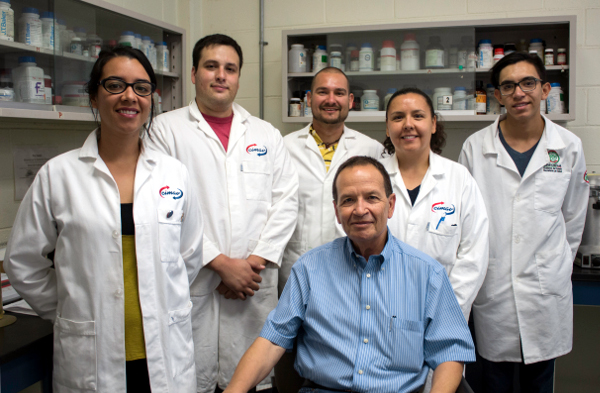Nanotoxicology and Biohydrometallurgy
Functionalization of nanomaterials with biological molecules
Cimav counts with an important multidisciplinary group focused on the scientific research of carbon nanotubes (CNTs). Through several years of work they have generated knowledge on their functionalization, toxicity, biomedical applications, and they even developed a technology for CNT production.
In this area the studies on carbon nanotubes for biomedical applications are focused on developing a vaccine against amoebiasis, as this is a public health issue.
Carbon nanotubes, through an acid treatment, allow for the incorporation of molecules known as radicals. These radicals, in turn, have the possibility of having another molecule attached (under certain synthesis conditions).
At the laboratory level, the researchers in Cimav managed to attach proteins of the amoeba’s membrane to the carbon nanotubes and they subsequently put them in contact with human cells. The studies showed that with this method the carbon nanotubes indeed produce an immune response against amoebas.
This scientific research project opens the possibility of creating a vaccine against amoebiasis.
In addition to this, specialists in Cimav demonstrated that carbon nanotubes stop being toxic if they do not exceed certain size, especially when they are purified (that means, when they are subject to acid treatment). This scientific contribution is relevant given the global controversy on the toxicity of CNTs.

The research work to develop a vaccine against amoebiasis is already being evaluated in mice in the laboratory.
To comply with the research protocols and to attend scientific ethics, Cimav’s specialists are also studying the effect of nanotube accumulation in some organs.
Also as part of this same project, the scientists try to extend the effectivity of this vaccine for many years.
Functionalization of nanoparticles with antibiotics
Breast cancer is one of the main causes of death worldwide, and according to the WHO this illness represents 16% of all the female cases of cancer.
For the treatment of this disease there are currently several drugs available in the market, among them Tamoxifen (TMX). Even though Tamoxifen provides good results, it also has secondary damages.
With the objective of avoiding the harmful effects in the treatment of breast cancer, scientists in Cimav study methods for controlled drug release.
Controlled drug release allows for medication to travel only to the sick part of the body through the so called carrier vehicles.
The carrier vehicles used in this research work are nanoparticles (nanodiamonds in this case) which possess excellent physical and chemical properties, scalability, size, surface, high adsorption rate and good biocompatibility.
The research consists in binding nanodiamonds with tamoxifen and a signal molecule such as Cadmium telluride (CdTe) and using them as carrier vehicles for the drug to arrive specifically to the cancerous cells. The scientific project is already being studied in the laboratory with human cancerous cells using healthy cells as control.
Toxicity of nanoparticles in fertile soil and evaluation of variability of microbial consortia
The knowledge on nanoparticles allowed Cimav’s researchers to enter into the agricultural sector, specifically the pecan tree, which produces pecan nuts.
According to SAGARPA (Mexico’s Secretary of Agriculture, Livestock, Rural Development, Fishing and Food), Mexico is the second producer in the world of this kind of nut. Due to the economic importance of this activity, specialists in Cimav conduct research projects related to this topic.
The projects are developed in several sub-lines of research:
- Biosolids. (as fertilizers) to increase the pecan tree’s yield.
- Copper nanoparticles in fertile soil of pecan tree plantations. The studies proved that adding copper oxide or copper to fertile soil to control bacteria or microorganisms modified the dynamics of microbial consortia associated to the pecan tree, with an effect on the tree’s health.
- Organic fertilization. In this project natural fertilizers and also copper, palladium, iron oxide, platinum and gold nanoparticles are incorporated and evaluated. The objective is to investigate how these nanoparticles have an effect on a cell, bacteria or fungus, whether the composition of soil microorganisms is modified or not. Also they seek to determine whether these nanoparticles are harmless or not. The project is developed in collaboration with Brazil: in Mexico the study was conducted in Chihuahua’s pecan tree zones and in Brazil in the Amazon rainforest.
- Phosphate-dissolving bacteria and nitrogen-fixing bacteria. The studies are focused on the isolation of these microorganisms because they have a positive impact on the crop’s productivity.
Extraction of metals with economic interest using bacteria
This research work consists in studying extremophile bacteria that facilitate obtaining metals (leaching refractory minerals in acid media).
For example there are bacteria that when attached to Sulphur minerals they create corrosion pores generating openings that reach where gold is found. Once this metal is extracted, cyanide is added to recover it.
There are extremophile bacteria in mineral deposits where acid water is found. With different types of bacteria that act under the same or under very similar conditions, pure copper, zinc and silver can also be obtained.
The use of microorganisms to obtain minerals is also a very economical method, although it involves a much slower process; however it is widely used in the world. For example, it is estimated that by 2025 in Chile, main producer of copper in the world, 70 or 80 percent of copper will be obtained through microorganisms. In Cananea, a mining town in Mexico, an important part of the copper is produced through extremophile bacteria.
The group from the area of Nanotoxicology and Biohydrometallurgy publishes in indexed journals with high impact factor; it trains human resources with an excellent academic level and conducts collaborative projects with national and international universities.
- Cytotoxicity of nanoparticles in model cells and microbial consortia.
- Development of carbon nanotube-based nanovaccines.
- Fabrication of nanocarriers for theragnosis.
